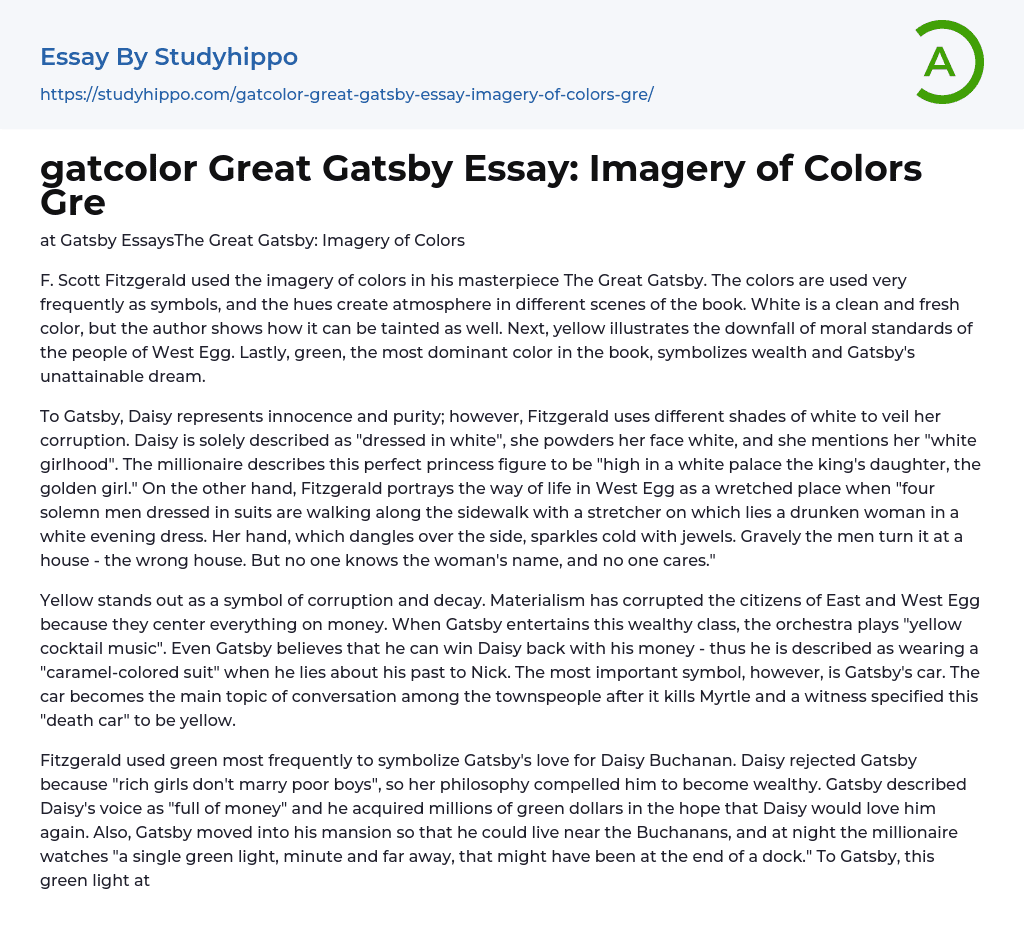at Gatsby EssaysThe Great Gatsby: Imagery of Colors
F. Scott Fitzgerald used the imagery of colors in his masterpiece The Great Gatsby. The colors are used very frequently as symbols, and the hues create atmosphere in different scenes of the book. White is a clean and fresh color, but the author shows how it can be tainted as well. Next, yellow illustrates the downfall of moral standards of the people of West Egg. Lastly, green, the most dominant color in the book, symbolizes wealth and Gatsby's unattainable dream.
To Gatsby, Daisy represents innocence and purity; however, Fitzgerald uses different shades of white to veil her corruption. Daisy is solely described as "dressed in white", she powders her face white, and she mentions her "white girlhood". The millionaire describes this perfect
...princess figure to be "high in a white palace the king's daughter, the golden girl." On the other hand, Fitzgerald portrays the way of life in West Egg as a wretched place when "four solemn men dressed in suits are walking along the sidewalk with a stretcher on which lies a drunken woman in a white evening dress. Her hand, which dangles over the side, sparkles cold with jewels. Gravely the men turn it at a house - the wrong house. But no one knows the woman's name, and no one cares."
Yellow stands out as a symbol of corruption and decay. Materialism has corrupted the citizens of East and West Egg because they center everything on money. When Gatsby entertains this wealthy class, the orchestra plays "yellow cocktail music". Even Gatsby believes that he can win Daisy back with his money - thus he
is described as wearing a "caramel-colored suit" when he lies about his past to Nick. The most important symbol, however, is Gatsby's car. The car becomes the main topic of conversation among the townspeople after it kills Myrtle and a witness specified this "death car" to be yellow.
Fitzgerald used green most frequently to symbolize Gatsby's love for Daisy Buchanan. Daisy rejected Gatsby because "rich girls don't marry poor boys", so her philosophy compelled him to become wealthy. Gatsby described Daisy's voice as "full of money" and he acquired millions of green dollars in the hope that Daisy would love him again. Also, Gatsby moved into his mansion so that he could live near the Buchanans, and at night the millionaire watches "a single green light, minute and far away, that might have been at the end of a dock." To Gatsby, this green light at Daisy's house symbolized hope and a chance to relive the past with his dream girl.
In The Great Gatsby, colors are employed throughout the pages to convey impressionistic, but important, images to the reader. White changes from an honest and sinless color to represent the corruption of the wealthy. Yellow symbolizes the unethical standards and death of this class as well. However, the most important color in this book, green, is the embodiment of hope and the American dream Gatsby hopes to attain with money.
- Aesthetics essays
- Art History essays
- Artist essays
- ballet essays
- Body Art essays
- Color essays
- Concert Review essays
- Creativity essays
- Cultural Anthropology essays
- Ethnography essays
- Harlem Renaissance essays
- Heritage essays
- Modernism essays
- Mona Lisa essays
- Pastoral essays
- Postmodernism essays
- Realism essays
- Symbolism essays
- Theatre essays
- Visual Arts essays
- Voice essays
- Work of art essays
- Aldous Huxley essays
- Alice Walker essays
- Amy tan essays
- Anne Bradstreet essays
- Anton Chekhov essays
- Arthur Miller essays
- Augustine essays
- Bertolt Brecht essays
- Booker T Washington essays
- Carol ann duffy essays
- Charles Dickens essays
- Charlotte Perkins Gilman essays
- Chinua Achebe essays
- Christina Rossetti essays
- Consider The Lobster essays
- Edgar Allan Poe essays
- Elizabeth Bishop essays
- Emily Dickinson essays
- Ernest Hemingway essays
- F. Scott Fitzgerald essays
- George Orwell essays
- Harper Lee essays
- Homer essays
- James Baldwin essays
- Jane Austen essays
- John Donne essays
- John Steinbeck essays
- Kate Chopin essays




